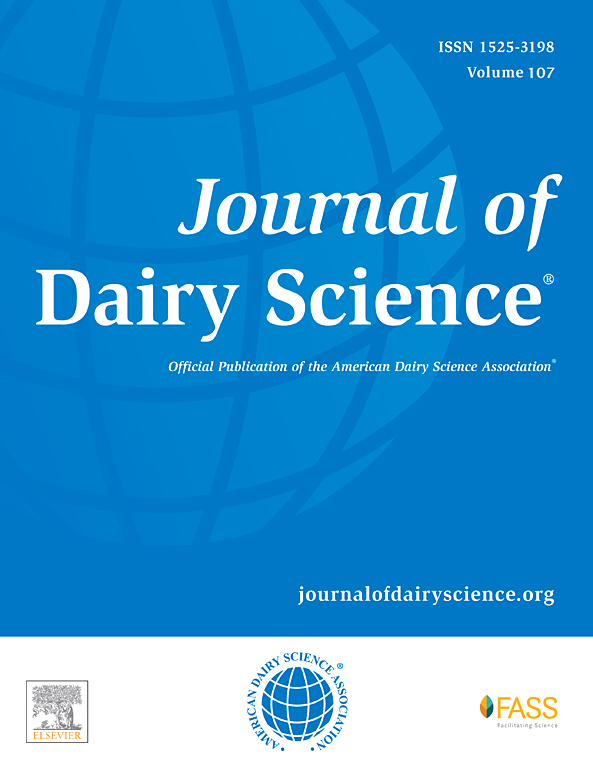育肥性状遗传优势不同的空怀母牛的发情活动。
IF 3.7
1区 农林科学
Q1 AGRICULTURE, DAIRY & ANIMAL SCIENCE
引用次数: 0
摘要
这项观察性研究确定了繁殖力性状的遗传优势对无性乳牛发情活动、持续时间和发情间隔的影响。我们还比较了有无受孕的发情活动,并确定了繁殖力性状遗传优劣对首次检测到发情活动时的年龄和体重的影响。在7-9月龄的荷斯坦-弗里斯兰小母牛身上安装了发情活动监测装置(Heatime,SCR Engineers),这些小母牛的繁殖力性状遗传优势为阳性或阴性(POS FertBV:平均+5%,n = 275;NEG FertBV:平均-5%,n = 249),活动数据收集至第一个繁殖期(15-17月龄)结束。当活动变化指数连续≥6 小时超过 19.2 个活动单位(AU)时,即定义为发情事件。共识别出 2434 个发情事件(POS FertBV:n = 1454;NEG FertBV:n = 980)。发情事件持续时间定义为首次超过阈值和活动降至阈值以下的时间段,且在前一事件结束后 24 小时内没有另一事件发生。这一定义包括一天内活动多次超过阈值的情况;这些情况被归类为一次发情事件。第二个衡量标准是高活动持续时间,定义为活动超过阈值的总时间。为了描述发情活动的特征,基线活动是根据前 7 天的活动确定的。计算峰值活动和总活动(高于基线的活动曲线下面积)。第五个变量是发情周期间隔,它代表了发情周期的长度。POS FertBV 母牛的总活动量和峰值活动量均大于 NEG FertBV 母牛(总活动量:548 AU vs 464 AU,SED = 19.6 AU;峰值活动量:72 AU vs 65 AU,差异标准误差 (SED) = 1.5 AU)。POS FertBV 组的平均发情事件持续时间和高活动持续时间分别为 15.1 小时和 15.0 小时,而 NEG FertBV 组分别为 14.1 小时和 14.1 小时(SED = 0.30 小时和 0.29 小时)。POS 和 NEG FertBV 母牛的发情间隔没有差异(19.5 vs 20.0 d,SED = 0.49)。与受孕相关的发情事件比与受孕无关的发情事件短(平均值 ± 平均值标准误差,高活动持续时间:13.0 ± 0.25 h):13.0 ± 0.25 h vs 13.9 ± 0.31 h,发情事件持续时间:13.1 ± 0.25 h vs 14 ± 0.32 h),总活动量较少(408 ± 15.2 vs 487 ± 18.2 AU)。在特定年龄(HR = 1.26,95% CI = 1.0 至 1.6)或体重(HR = 1.35,95% CI = 1.1 至 1.6)下,POS FertBV 母牛比 NEG FertBV 母牛更有可能发生第一次发情活动。这项研究的结果提供了证据,证明繁殖力性状的正遗传优越性与更明显的发情表现相关。因此,发情表现性状有可能作为生育力遗传优势的早期预测因子。本文章由计算机程序翻译,如有差异,请以英文原文为准。
Estrous activity in nulliparous heifers with divergent genetic merit for fertility traits
This observational study determined the effect of genetic merit for fertility traits on estrous activity and duration and interestrous interval in nulliparous dairy heifers. We also compared estrous activity between estrous events with or without conception and determined the effect of genetic merit for fertility traits on age and BW at time of first detected estrous activity event. Activity monitoring devices (Heatime, SCR-Engineers) were fitted to Holstein-Friesian heifers aged 7 to 9 mo with positive or negative genetic merit for fertility traits (POS FertBV: average +5%, n = 275; NEG FertBV: average −5%, n = 249) and activity data were collected to the end of the first breeding period (15–17 mo). An estrous event was defined as when the activity change index exceeded 19.2 activity units (AU) for ≥6 consecutive hours. In total, 2,434 estrous events were identified (POS FertBV: n = 1,454; NEG FertBV: n = 980). Estrous event duration was defined as the period when the threshold was first exceeded and when activity dropped below threshold, without another event starting within 24 h of the end of the previous event. This definition included occurrences where activity crossed the threshold multiple times in a day; these were classified as a single estrous event. A second measure, high activity duration, was defined as the total time activity exceeded the threshold. To characterize estrous activity, baseline activity was determined from the previous 7 d of activity. Peak activity and total activity (area under the curve of activity above baseline) were calculated. A fifth variable, interestrous interval, was calculated as a proxy for estrous cycle length. Total activity and peak activity were greater in POS than NEG FertBV heifers (total activity: 548 vs. 464 AU, SED = 19.6 AU; peak activity: 72 vs. 65 AU, SE of the difference [SED] = 1.5 AU). The POS FertBV group had a mean estrous event duration and high activity duration of 15.1 and 15.0 h, compared with 14.1 and 14.1 h for the NEG FertBV group (SED = 0.30 and 0.29 h, respectively). Inter-estrous interval did not differ between POS FertBV and NEG FertBV heifers (19.5 vs. 20.0 d, SED = 0.49). Estrous events associated with conception were shorter than those not associated with conception (mean ± SEM, high activity duration: 13.0 ± 0.25 h vs. 13.9 ± 0.31 h, estrous event duration: 13.1 ± 0.25 h vs. 14 ± 0.32 h) and had less total activity (408 ± 15.2 vs. 487 ± 18.2 AU). The POS FertBV heifers were more likely to have their first estrous activity event than NEG FertBV heifers by a given age (hazard ratio [HR] = 1.26, 95% CI = 1.0–1.6) or BW (HR = 1.35, 95% CI = 1.1–1.6). The outcomes of this study provide evidence that positive genetic merit for fertility traits is associated with more overt estrous expression. Therefore, estrous expression traits may have potential to be used as earlier-in-life predictors of genetic merit for fertility.
求助全文
通过发布文献求助,成功后即可免费获取论文全文。
去求助
来源期刊

Journal of Dairy Science
农林科学-奶制品与动物科学
CiteScore
7.90
自引率
17.10%
发文量
784
审稿时长
4.2 months
期刊介绍:
The official journal of the American Dairy Science Association®, Journal of Dairy Science® (JDS) is the leading peer-reviewed general dairy research journal in the world. JDS readers represent education, industry, and government agencies in more than 70 countries with interests in biochemistry, breeding, economics, engineering, environment, food science, genetics, microbiology, nutrition, pathology, physiology, processing, public health, quality assurance, and sanitation.
 求助内容:
求助内容: 应助结果提醒方式:
应助结果提醒方式:


